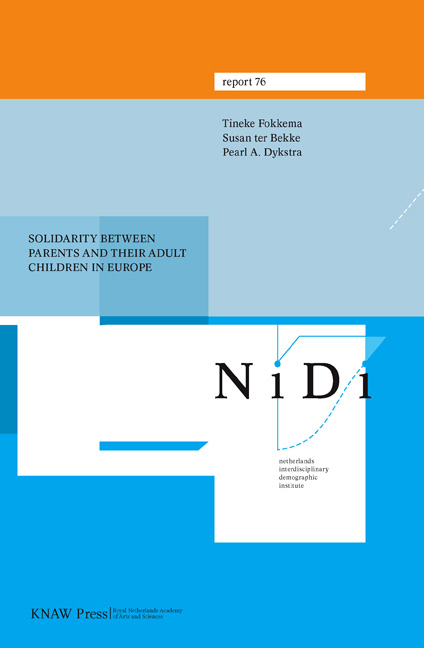Book contents
- Frontmatter
- Contents
- List of Figures
- List of Tables
- Executive Summary
- Acknowledgement
- 1 Introduction
- 2 Geographical Proximity
- 3 Contacts
- 4 Family Care Obligations
- 5 Support Exchange
- 6 Typology of Late-Life Families
- 7 Conclusion and Discussion
- References
- Appendix Measurement of the Independent Variables
- List of NIDI Reports
6 - Typology of Late-Life Families
Published online by Cambridge University Press: 20 January 2021
- Frontmatter
- Contents
- List of Figures
- List of Tables
- Executive Summary
- Acknowledgement
- 1 Introduction
- 2 Geographical Proximity
- 3 Contacts
- 4 Family Care Obligations
- 5 Support Exchange
- 6 Typology of Late-Life Families
- 7 Conclusion and Discussion
- References
- Appendix Measurement of the Independent Variables
- List of NIDI Reports
Summary
Introduction
Previous chapters subsequently focused on geographical proximity, frequency of contact, family care obligations and support exchange, representing the structural, association, normative and functional solidarity in the Bengtson and Roberts (1991) model, between parents and their adult children. The focus was on describing and explaining the current variations in each specific domain of intergenerational solidarity within and across European countries. In this chapter, we will contrast the four solidarity domains simultaneously, in an aim to find different late-life family types. In other words, we will examine the diversity in adult children-parent relationships on the basis of different domains of intergenerational solidarity. In this way, we gain a better understanding of the current complexities in the relationships ageing parents have with their adult children. To our knowledge, this is the first time that multiple domains are considered simultaneously in more than one country. The challenging research question is whether different types of late-life families can be empirically distinguished, and if so, what their incidence is, and whether their distribution varies across and within European societies.
Latent Class Analysis (LCA) was applied to construct the typology of late-life families. In LCA one assumes probabilistic rather than deterministic relationships between the latent construct (the concept of interest, in this case solidarity between parents and their adult children) and manifest indicators (the measures actually used) (Hagenaars & Halman, 1989; Yamaguchi, 2000). A basic assumption of LCA is conditional dependence, which means that associations between manifest indicators exist only insofar they measure the same latent construct. LCA has the advantage that the classes of the latent construct are discrete and need not be ordered along a continuum (Clogg, 1995).
The input for LCA is a cross-classification table of the scores for each variable in the analysis. In order to have a manageable number of cells in the data matrix, it is common to use dichotomous variables (cf. Hogan et al., 1993; Silverstein & Bengtson, 1997; Van Gaalen & Dykstra, 2006). The dichotomous variables (0 = no, 1 = yes) we constructed with regard to geographical proximity and the frequency of contact were whether the parent had at least one child living within a 5-kilometre radius and whether the parent had more than weekly contact with one or more children, respectively.
- Type
- Chapter
- Information
- Publisher: Amsterdam University PressPrint publication year: 2008



